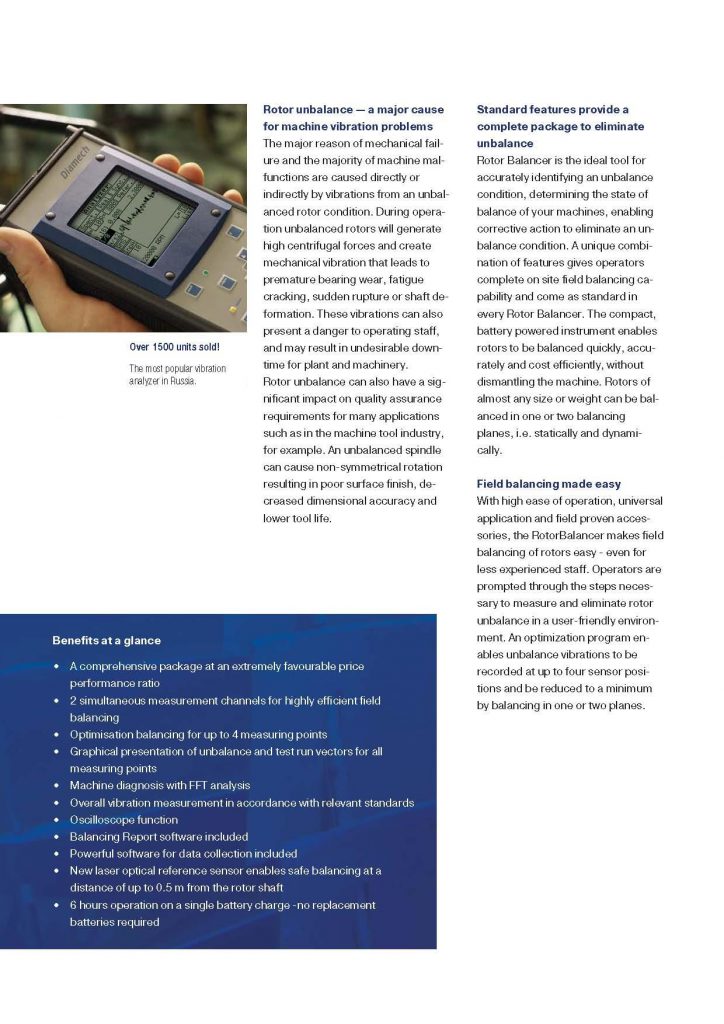RB-40 Rotor Balancer
Rotor Balancer performs a broad-band measurement of absolute bearing vibrations and delivers information on the condition of the machine.
Rotor Balancer is suitable for field balancing of rotors, e.g. on pumps, blowers, electric motors or compressors.
To identify causes of vibration, Rotor Balancer provides two powerful methods of performing FFT frequency analysis: FFT analysis with constant absolute and relative band width. Both variants enable vibration mixtures measured on a machine to be separated into their harmonic portions and displayed with frequency and amplitude in the form of spectral lines. On the basis of the measured frequencies, causes of vibration can be detected and unbalanced rotors identified.
All results can be stored along with a description of the machine, sensor position and date and time, and downloaded to a PC or laptop computer. The Balancing-Report PC software supplied with the instrument enables measurement results to be output in the form of graphs or tables and imported to Windows Office programs, and permits the creation of professional balancing and measurement reports.
Technical Data
| ■ | Field balancing of rotors in one and two planes |
| ■ | Measurement of overall vibrations for evaluation of the machine condition |
| ■ | Frequency analysis for identification of machine faults and damages |
| ■ | Start-up and run-down analysis of the first harmonic for the detection of machine resonance’s |
| ■ | Envelope spectrum mesurements |
| ■ | Display of the overall vibrations as well as of the first harmonic vs. time |
| ■ | Visualization of vibration time-signature |
| ■ | Bump test measurements |
| ■ | Ball and roller bearing fault detection |
Measurement channels
| ■ | 2 channels for vibration |
| ■ | 1channel for rotor speed and reference signal |
Measurement values
| ■ | Vibration displacement in µm |
| ■ | Vibration velocity in mm/s |
| ■ | Vibration acceleration in m/s2 |
Signal detection types
| ■ | RMS value |
| ■ | Peak-to-peak value |
| ■ | Peak value |
Field balancing
| ■ | Easy-to-understand operator dialog, integrated balancing calculator, polar presentation of unbalance and test run vectors and printed balancing reports via PC/Laptop |
| ■ | Balancing rotor speed: 120 to 20,000 rpm |
| ■ | Number of balancing planes: 1 or 2 |
| ■ | Number of measuring points: up to 4 (enables optimized balancing procedures) |
| ■ | Archiving of rotor influence coefficients to enable simplified balancing procedures in repeat situations |
| ■ | Broadband vibration measurement in pre-selectable frequency ranges |
| ■ | High-pass steps 2/5/10/20/50/ 100/200/500/1,000 Hz |
| ■ | Low-pass steps 100/200/500/ 1,000/2,000/5,000/10,000 Hz |
| ■ | Number of averages: 0 up to 100 |
Measurement of overall vibrations
Frequency analysis
| ■ | Narrow band measurement for separation of the machine vibration into their harmonic portions |
| ■ | FFT analysis, either without external trigger (free run) or with rotor-synchronous data acquisition |
| ■ | High-pass steps: 5/10/20/50/100/200/500/1,000 Hz |
| ■ | Low-pass steps: 100/200/500/1,000/2,000/5,000/10,000 Hz |
| ■ | 2/5/10/20 harmonic with rotor-synchronous data acquisition |
| ■ | Resolution: 100/200/400/800 lines |
| ■ | Number of averages: 0 to 100 |
| ■ | Windowing functions: Hanning and Uniform (Rectangular) |
| ■ | FFT analysis in the frequency range 5 to 10,000 Hz by means of 33 frequency bands with a constant relative bandwidth (26%) and with logarithmic graphical display |
Start-up and run-down analysis
| ■ | Measurement, archiving and graphical display of the amplitude and the phase angle of the first harmonic in pre-selec-table rotor speed ranges |
| ■ | Max. rotor speed range: 120 to 9,000 rpm |
| ■ | Resolution: 100 lines |
Overall vibration and first harmonic vs. time
| ■ | Measurement, archiving and graphical display of the characteristic values for overall vibration as well as for amplitude and phase angle of the first harmonic in pre-selectable time ranges |
| ■ | Number of averages: 0 to 100 |
| ■ | Number of depictable data sets: 5 to 100 |
| ■ | Visualization of the vibration waveform |
| ■ | Frequency range: 2 to 10,000 Hz, with rotor-synchronous data acquisition up to the 20 harmonic |
| ■ | Sampling period: 2/5/10/20/ 50/100/200/500/ 1,000/2,000/5,000 ms |
| ■ | Number of samples: 256/512/ 1,024/2,048 |
| ■ | Number of averages with rotor-synchronous data acquisition: 0 to 100 |
| ■ | Number of depictable data sets: 5 to 100 |
| ■ | Resolution: 256/512/1,024/2,048 points |
Vibration time-signature
General features
| ■ | Display: Monochrome LCD with 128 x 128 Pixel and backlit |
| ■ | A/D-converter: 14 Bit resolutions |
| ■ | Storage capacity of the internal EEPROM memory: 2 MB (for firmware and measurement data) |
| ■ | Accuracy of the indicator unit: 5% |
| ■ | USB interface for data upload to PC/Laptop |
| ■ | With built-in rechargeable battery, storage capacity: 1,6 Ah |
| ■ | Typical battery operation period: not less than 6 h |
| ■ | Battery charge time: not more than 3 h |
| ■ | Power and charger unit for 240 V, 50/60 Hz |
Power supply
| ■ | Aluminum housing, rugged and shockproof design |
| ■ | Protection class: IP 54 |
| ■ | Operating temperature range: -10° to +50° C |
| ■ | Relative air humidity: 0 to 95%, not condensing |
| ■ | Dimensions: 220 x 110 x 38 mm |
| ■ | Weight: 900 g     |




